What if cooking and preparing meals at home every day became a fulfilling experience that you actually looked forward to, rather than feeling like a chore?
This mindset shift can happen when you pay attention to your energy vibration and make an effort to eat high-vibration foods. While this is common terminology in the mindfulness and meditation communities, it is fairly new to most people.
We all know how important it is to eat healthy foods. So why do we frequently turn to fast food and processed snacks?
Most people would say it’s because processed food is convenient. You can take these foods on-the-go as an easy snack or even prepare them in a microwave in a few short minutes. However, this dependence on convenience has caused us to miss out on the long-term benefits of eating organic and healthier foods.
Throughout this article, you’ll learn more about why eating healthier matters and the types of high-vibration foods you should add to your daily diet.
I’ll also talk about how you can use this newfound passion for energy vibration and nutrition to create a diet quiz that encourages other people in your audience to prioritize their health, too.
Launching a quiz can help you:
- Generate more leads for your business
- Qualify your leads so you know who to work with
- Build your email list with quality subscribers
- Understand what your audience’s habits and motivations are
- Teach others about the importance of health and nutrition
Since nutrition can be a touchy subject to discuss, a quiz will help you gather important information about your audience and share educational tips while respecting their health journey. And so, your quiz will provide a positive and welcoming introduction to your brand.
It’s important to note that eating high-vibration foods is less about dieting and more about building a healthier lifestyle. When you have more energy throughout the day, your focus, discipline, and sleep quality will improve.
Are you ready to learn more about quiz building and high-vibration foods?
You can either keep reading or jump to a section that interests you:
- What are high-vibration foods?
- What does a food vibration chart look like?
- Popular types of high-vibration foods
- Low-vibration foods to avoid
- How to use this knowledge to create a diet quiz
- 10 questions to use in your high-vibration foods quiz
Let’s begin by exploring what vibration energy looks like and how it relates to our food.
What are high-vibration foods?
Many people in the mindfulness community believe that all things have vibrational forces, but few understand their effects on our daily lives. Karson McGinley, a yoga teacher and life coach, says that a vibration is “a state of being, the atmosphere, or the energetic quality of a person, place, thought, or thing.” Even Albert Einstein said, “Everything in life is a vibration.”
Karson also teaches about vibrational forces and says they’ll help you subtly decide whether to move closer to someone who wears a warm smile on their face or move away from someone who looks or sounds angry. By thoughtfully examining vibrations, you’ll be more cognizant of how different things affect your health and happiness.
You might now be wondering what all this has to do with food.
If mindfulness experts teach that everything is made of vibrational energy, they’re talking about your food, too. When food is cultivated from the ground and made organically, its energy will naturally be higher than overly processed or fried foods.
Gurus say that gratitude, truth, and love have the highest energy vibrations, which gives us our first look into how this all relates to our diets. Historically, people have supported this point of view, too. The ancient Greeks believed they could lift the energy vibration of food before consuming it. When preparing their food, they performed dances and songs while kissing and blessing their dishes.
They believed preparing food slowly and lovingly would add good energy to the dish, allowing them to give thanks for the food. It’s a practice that is still around today, hundreds of years later.
While this cooking practice seems euphoric and almost magical, most of us will think we don’t have time for this practice in our busy lives. While it may be difficult to do this for every meal, we can take the principles of this ritual to create a high-vibrational diet.
Simply eating more nutritious foods that are rich in antioxidants, vitamins, and minerals is a great place to start. If you’re not sure which foods should make the list, continue reading for some healthy alternatives to processed foods.
What does a food vibration chart look like?
One of the easiest ways to determine which foods are best for your health is to look at a food vibration chart.
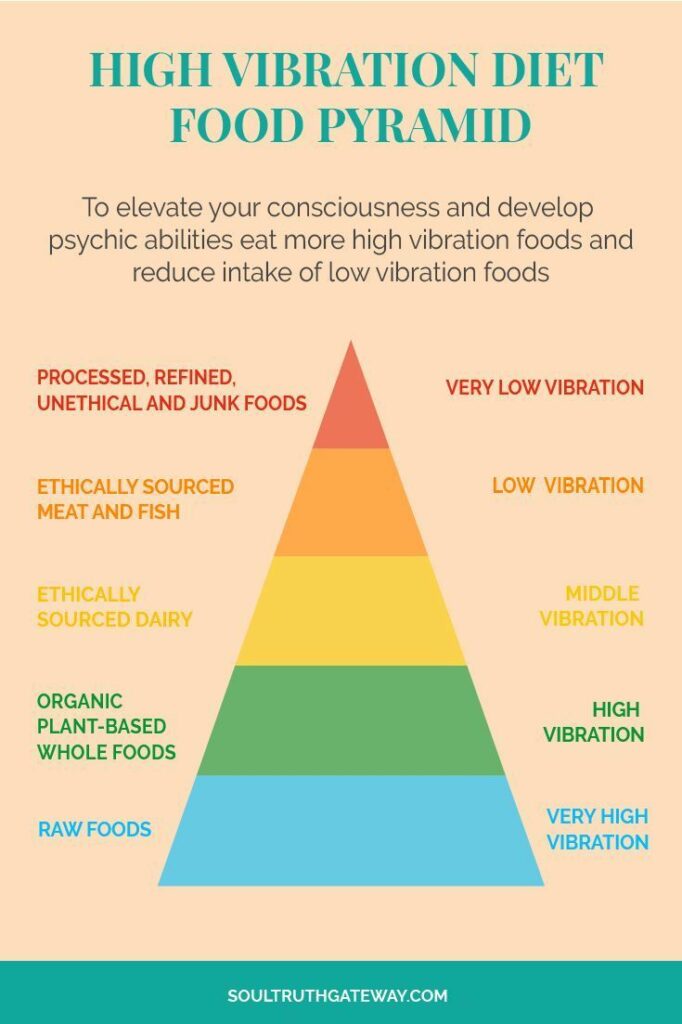
Shaped like a pyramid, this image lists food categories in order of their healthfulness. At the top of the chart, you’ll find junk foods, sugary drinks, and alcohol. At the bottom, you’ll find go-to high-vibration foods like leafy greens and fruits.
The hope is to create a diet that includes more foods and drinks from the bottom sections of the food vibration chart and less of those from the top. No one’s diet is perfect, but this is a good resource to keep in mind when you choose foods to eat each day.
Popular types of high-vibration foods
If you’re wondering which foods have the highest energy, look no further. This section breaks down the most common high-vibration foods and explores what makes them equally nutritious and delicious.
Some of these foods may already be in your diet, while others may inspire you to get creative with your meal planning. Make a mental checklist of the foods you already love to eat and think about how you could fit a few others into your meals and snacks.
Keep reading to discover the health benefits of these foods, or simply click the food you’re most interested in learning about below:
- Wild berries
- Dark leafy greens
- Raw herbs
- Spices
- Sprouts
- Fermented foods and drinks
- Avocados
- Raw cacao
- Fresh-pressed green juice
- Raw nuts
- Legumes and beans
- Cold-pressed organic oils
- Herbal teas
Wild berries
Organic fruits have earned a spot on the high-vibration food chart, but wild berries are said to be the best of the best. They’re loaded with antioxidants, high in fiber, and a great way to help your body fight inflammation.
Nutritionists suggest incorporating blueberries, raspberries, blackberries, and strawberries into your diet. They provide nutrients you can’t get anywhere else and can even be good for your skin. They’re often referred to as a superfood, which are nutrient-rich, non-processed foods that are full of health benefits.
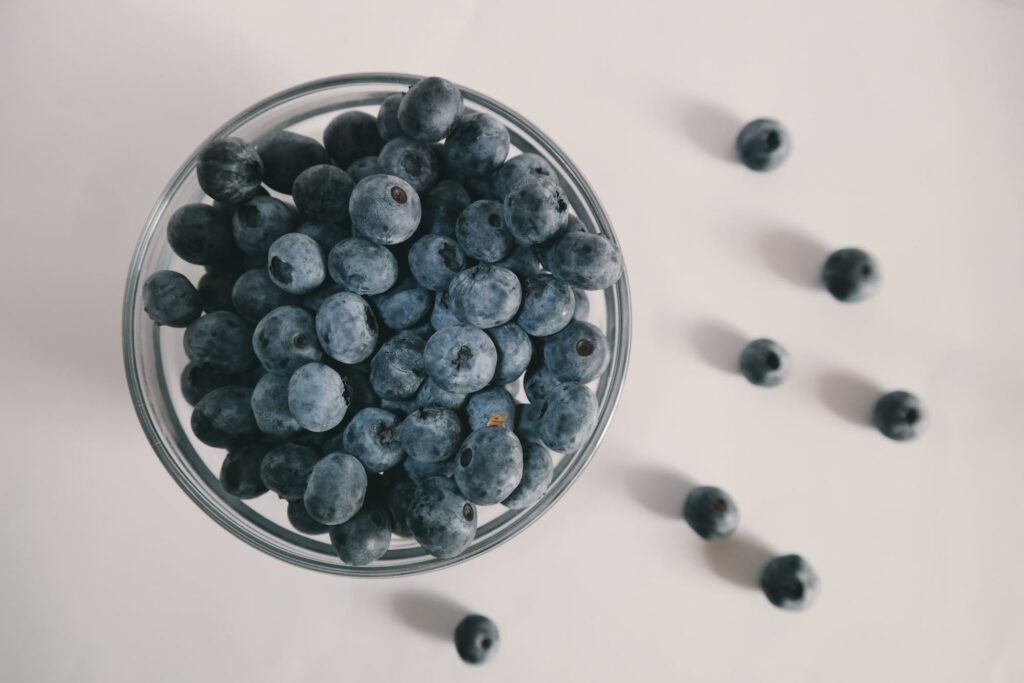
Dark leafy greens
Leafy greens are packed with fiber, vitamins, and minerals that are essential to your daily diet. Luckily, they are also low in calories. These dark leafy greens include kale, spinach, collard greens, cabbage, romaine lettuce, arugula, and more.
While most organic vegetables would make the high-vibration food chart, dark leafy greens are especially good for you. They support the immune system, relieve stress, and support optimal gut health for less stomach bloating. It doesn’t hurt that they also help your skin glow and clear up acne!
If you want to keep your memory sharp at any age and protect your health, dark leafy greens should be your go-to food of choice. There’s a reason why moms always say to eat your vegetables!

Raw herbs
Herbs like basil, cilantro, and chives are great for you! Fresh herbs can boost your attitude and energetic vibration and improve your nutritional intake. Raw herbs can even help prevent or manage heart disease, cancer, and diabetes.
Herbs can be added to almost any dish, from pasta to chicken to fish to soups. They enhance the flavor, smell, and even the appearance of meals.
When you’re ready to incorporate more herbs into your diet, you could grow an easy, at-home herb garden.
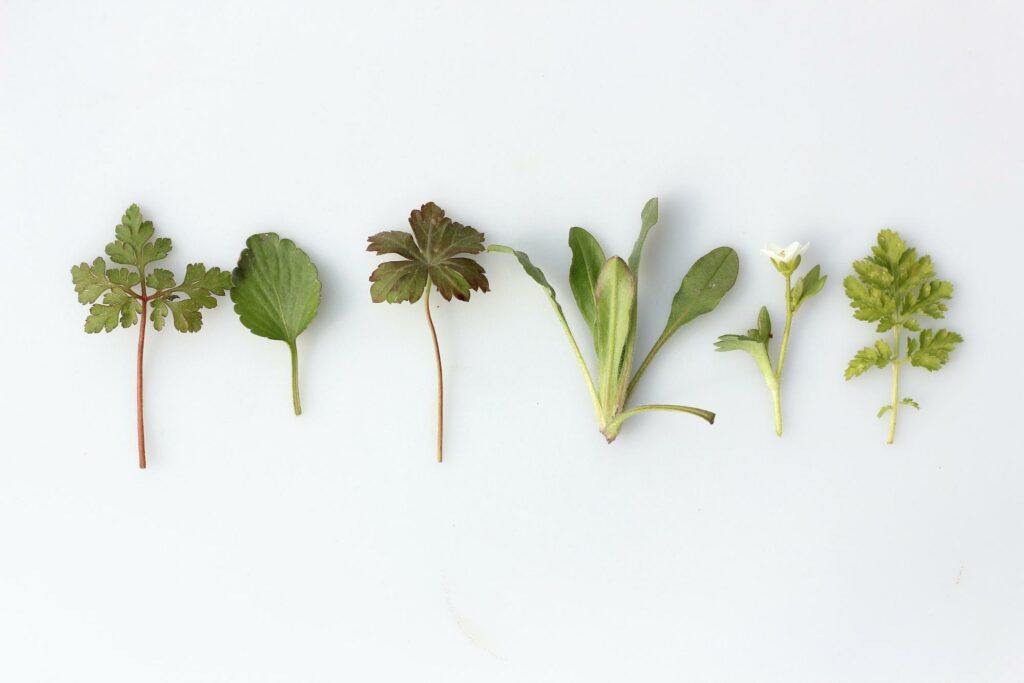
Spices
Spices not only enhance the smell and flavor of your food but also have healing properties. One Harvard study found that adding spices to food once a day lowers mortality rates by as much as 14 percent.
Spices can also speed up your metabolism (which is great for those who are considering losing weight) and kill harmful bacteria in the body. It’s good to add some (literal) spice to your life and diet.
Here are the more prominent health benefits of high-vibration spices:
- Cinnamon is known for lowering your blood sugar and reducing high cholesterol levels.
- Turmeric reduces brain inflammation, which is commonly linked to depression and Alzheimer’s disease.
- Ginger can relieve nausea and also treat upset stomachs.
- Garlic has been known to boost heart health and reduce high cholesterol levels.
- Cayenne can ease pain and reduce ulcers.
Spices are fun to experiment with in the kitchen, but you may want to follow a few best practices to ensure you’re getting the full health benefits from them.
Nutritionist Diane Vizthum recommends simmering or stewing foods with spices because it enhances their antioxidant levels. Frying or grilling with spices can decrease their benefits. Keep this in mind the next time you prepare a meal with spices.

Sprouts
Sprouts, a longtime staple in Chinese cuisine, are rich in vitamin K, which helps foster healthy bone growth and proper blood clotting. It’s also been said that sprouts have 100 times more protein enzymes than other uncooked vegetables, making them an even healthier option.
Sprouts can be added to salads, soups, sandwiches, stir fry dishes, and more. The most common sprouts include broccoli sprouts, peas, watercress, mung bean, sunflower seeds, wheatgrass, and alfalfa. These versatile sprouts are low in calories and high in fiber. You can even grow them at home inside a jar!
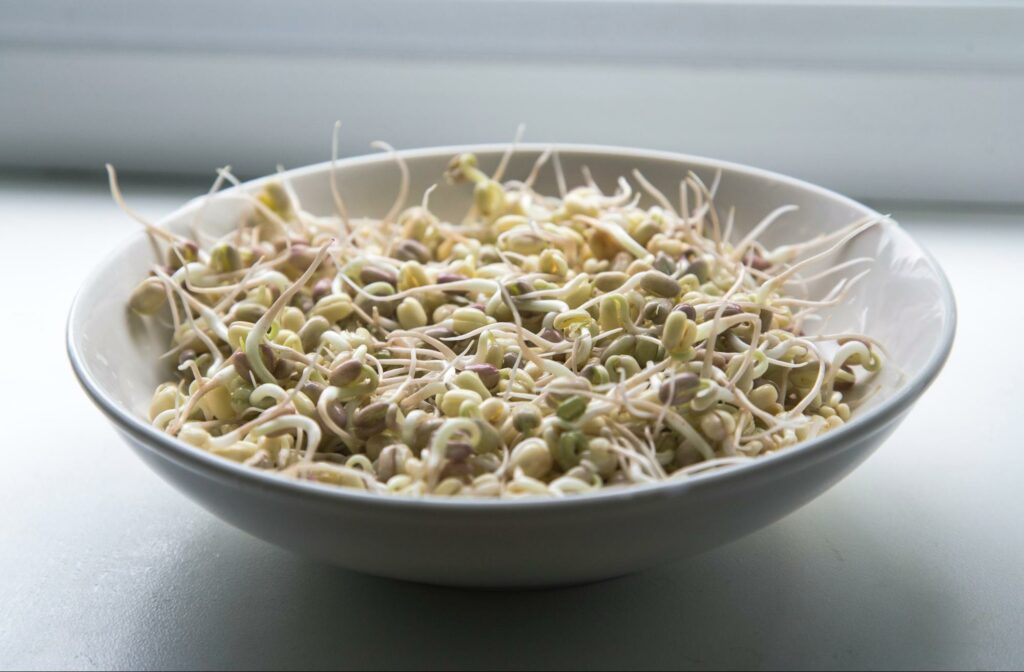
Fermented foods and drinks
Have you noticed kombucha and other fermented drinks becoming more popular? That’s because the wellness industry recognizes the health benefits of fermented foods! Fermented foods were originally produced to preserve foods, improve flavor, and eliminate food toxins.
While this remains true today, there are far more health benefits to fermentation. It may seem odd at first, but the process of fermentation helps create beneficial bacteria that your body and gut need. These bacteria can improve your immunity, digestion, and even help you lose weight.
Common fermented foods include sauerkraut, pickles, kimchi, and sourdough bread. If you’re looking to drink these probiotics rather than eat them, kombucha is a great option. Kombucha is tart, fizzy, and tastes great. It’s a fantastic alternative to sodas and artificially flavored waters.
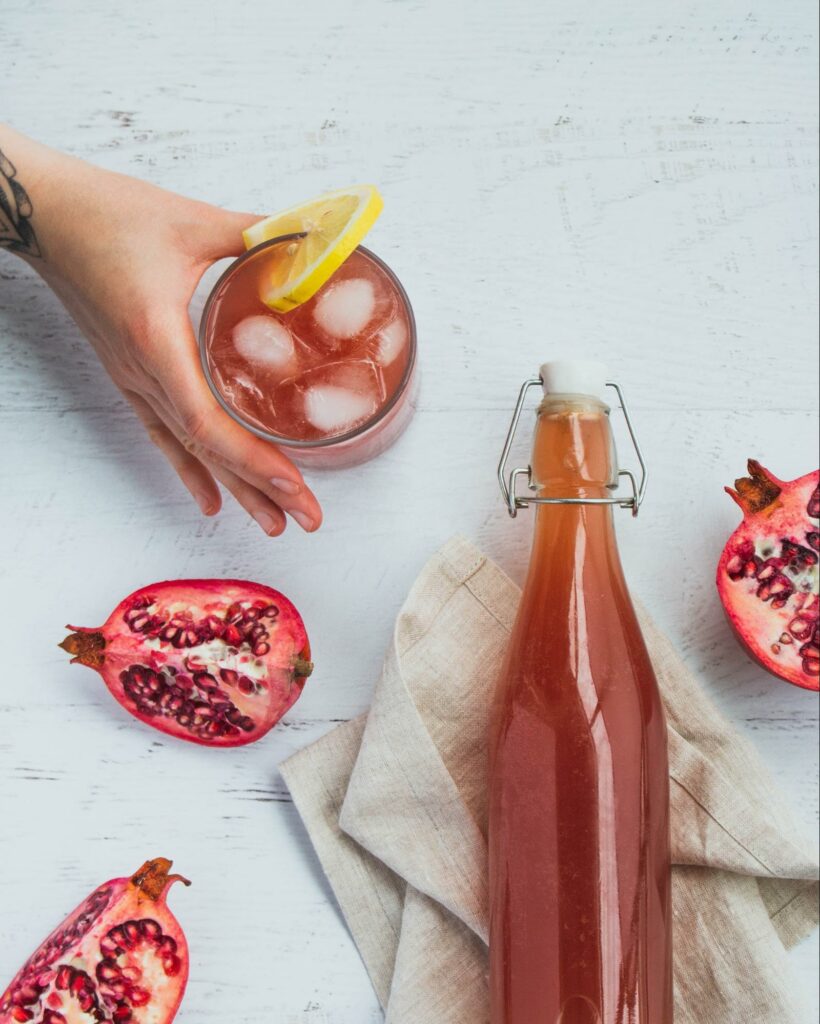
Avocados
Avocados are rich in healthy fats. If you find yourself reaching for snacks that are greasy or high in sodium, avocados might be a good food to introduce into your diet.
Avocados are known for improving digestion, decreasing the risk of depression, and protecting against cancer. They’re also the only fruit to provide healthy fatty acids along with almost twenty vitamins and minerals.
Eat avocados on their own or add them to other meals with a few spices for added flavor. You can use avocados, AKA millennials’ favorite food, to make guacamole (with tomatoes and a spritz of lime). You can also add avocados to salads, sandwiches, egg dishes, and pasta. Avocados have become a breakfast staple for many!
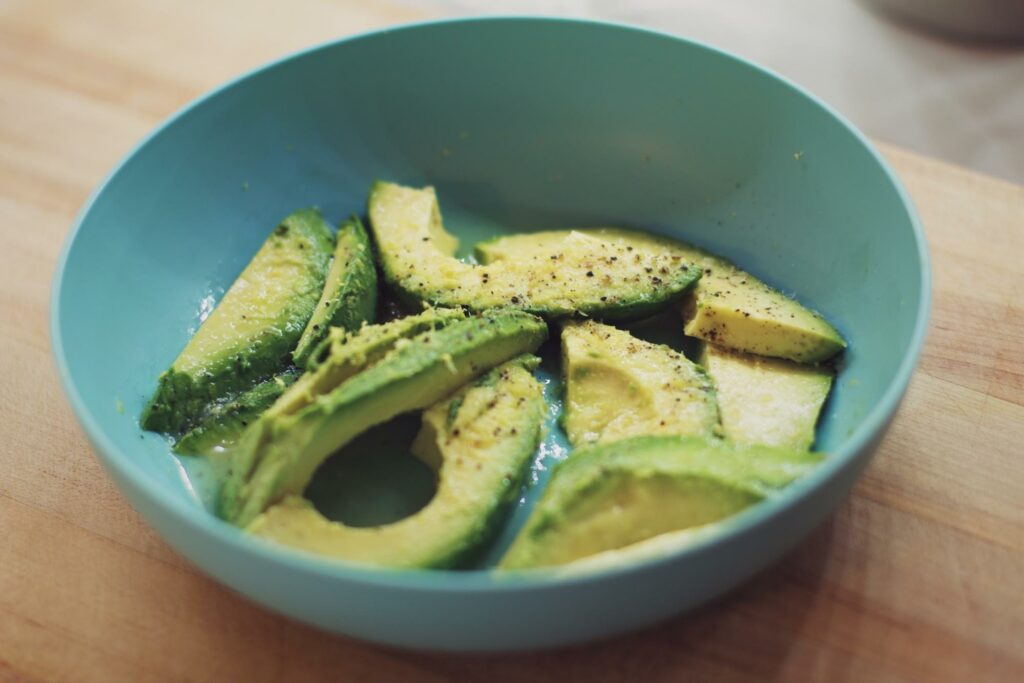
Raw cacao
Do you find yourself craving a bar of chocolate on a stressful day or a mug of hot chocolate in the winter? Instead of reaching for milk chocolate, which can do more harm than good, try to incorporate raw cacao into your diet.
Originating in the Amazon forest, powdered cacao is considered a superfood for its antioxidant properties. Look for raw cacao that hasn’t been processed to take advantage of all the health benefits that come with it.
Eating cacao has been said to improve people’s mood, prevent heart disease, and lower blood pressure. Consuming dark chocolate and cacao can also be beneficial for those with Type 2 diabetes. For even more flavor, add a little coconut or use it to make healthy baked goods!
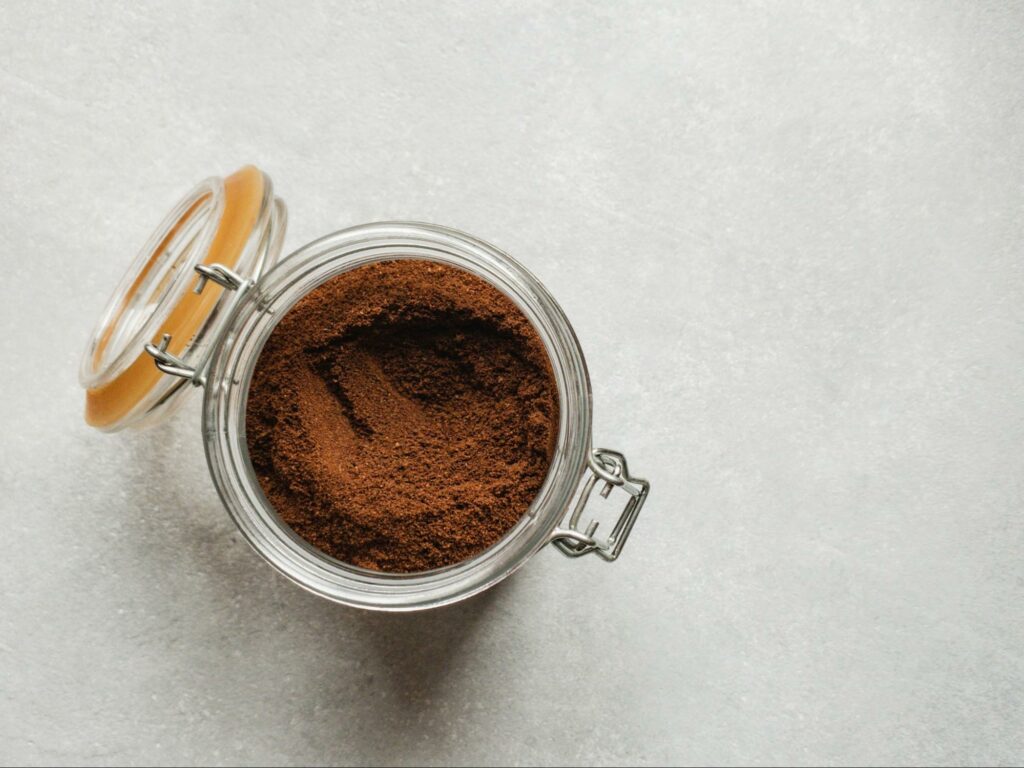
Fresh-pressed green juice
When no sugar is added, fresh-pressed juices are a great and easy way to add more nutrition to your diet. There are endless combinations you can experiment with.
Common ingredients for green juices include:
- Kale
- Cucumber
- Celery
- Apples
- Carrots
- Spinach
- Ginger
- Parsley
- Lemon or lime
Rich in antioxidants, fresh-pressed green juices can help you sustain energy throughout the day without having to rely on caffeine or other stimulants. Green juices ensure you get the vitamins and minerals you need to keep from feeling fatigued.
The wellness industry loves to sing the praises of fresh-pressed juice, although experts urge people to refrain from using green juices as a meal substitute. You’ll need additional proteins and minerals that you can’t get from juicing, so it is best to use juices as a midday snack.
While making your own green juice at home can be easy and nutritious, it doesn’t mean you shouldn’t consume other vegetables and fruits throughout the day. Juicing discards the essential fibers, so pair juices with raw foods. However, pureeing the ingredients in a blender will retain the nutrients, making this method a good option.
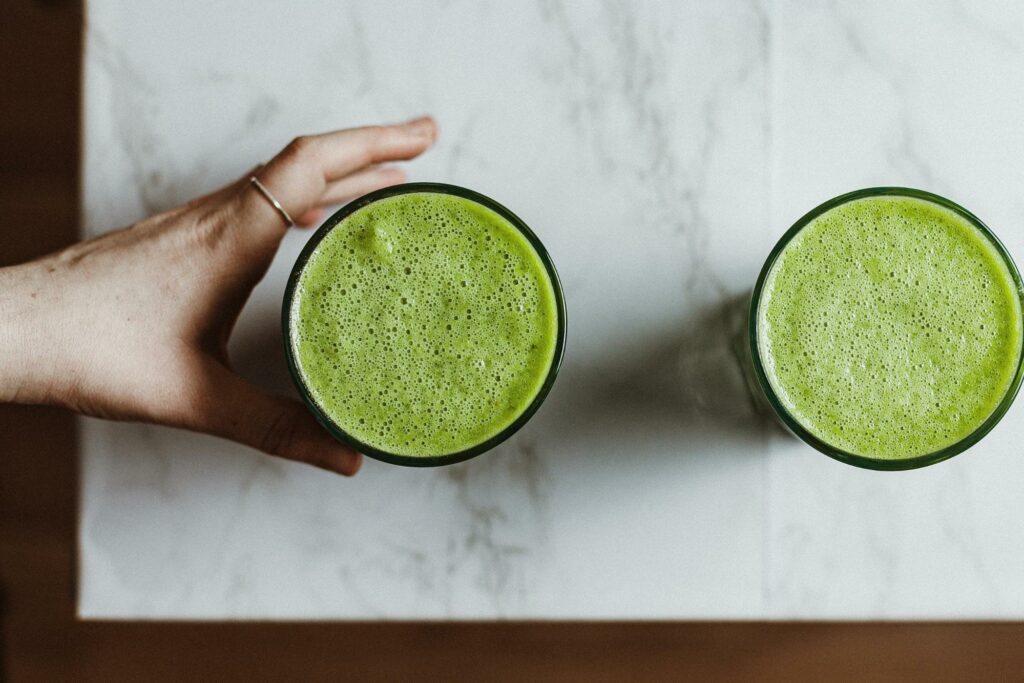
Raw nuts
Raw nuts are a great source of healthy protein and fat. Like other high-vibration foods, nuts are loaded with antioxidants and aid in weight loss. They can also be used to lower cholesterol, reduce inflammation, and reduce the risk of heart attack and stroke.
The next time you go to the grocery store, add these raw nuts to your cart, keeping in mind some facts:
- Almonds are higher in calcium than any other nut.
- Cashews are high in iron and magnesium.
- Walnuts are rich in omega 3 fats, antioxidants, and phytosterols.
- Pecans are especially beneficial for men in relieving enlarged prostates.
- Pistachios are low in calories and high in potassium.
Choose unsalted and raw nuts, so you know they’ve kept all of their nutritional value. Eat nuts as a snack or chop and add to meals, for example.
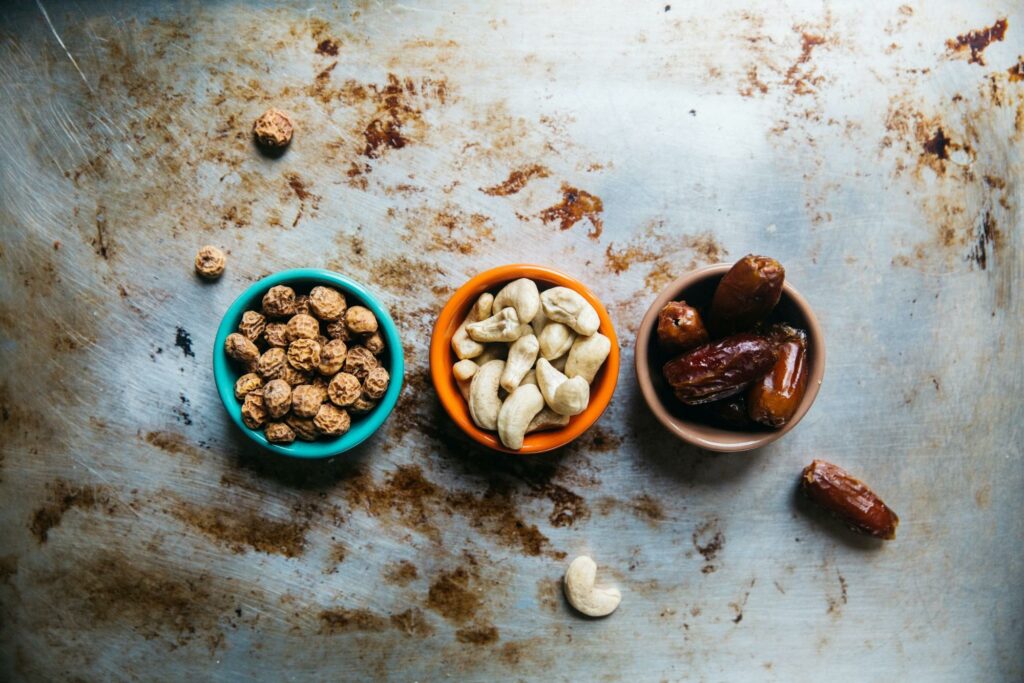
Legumes and beans
A great source of protein and fiber, legumes and beans are a staple for vegetarians and vegans who are looking for a meat alternative. It also helps that they are lower in saturated fats than red meats.
Legumes are essentially edible seeds or pods that grow from certain plants. Common legumes include lentils, chickpeas, peas, black beans, soybeans, pinto beans, kidney beans, and even peanuts. They can be prepared in many ways, from baked to canned to cooked to dried.
Legumes are typically low in fat and don’t contain any cholesterol. They’re high in folate, potassium, iron, and magnesium, which are a few of the minerals you need for a healthy, well-rounded diet.
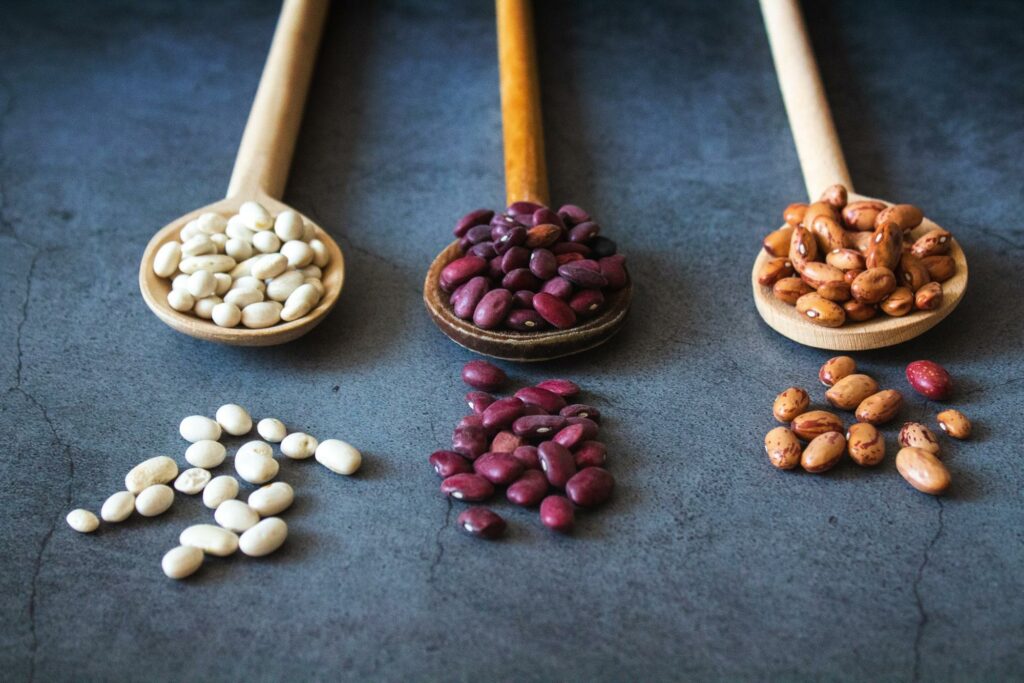
Cold-pressed organic oils
Many people cook dishes with oils, but when was the last time you checked the nutritional facts of the oil you’re using? Not all oils are created equal. Some are healthier than others, so let’s talk more about why cold-pressed organic oils are the way to go.
Cold pressing is the process of making oils without heat or chemicals, meaning the oil will retain more of its nutritional value. The result is an organic oil that is high in nutrients and healthy fats. This includes coconut, flax, avocado, sesame, and olive oils.
Organic olive oil is better for the environment and your health than conventional olive oil, as it keeps pesticides and other harmful chemicals from your food. You can use cold-pressed organic oils for cooking, simmering, or dipping. Once you start preparing foods with these oils, you’ll be hooked for life!
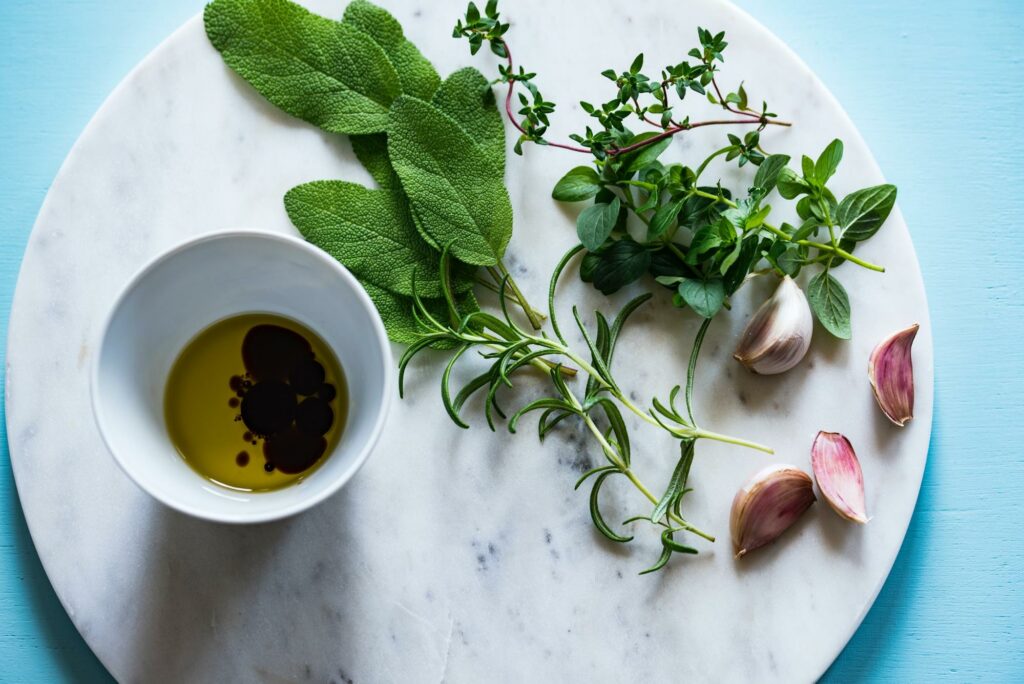
Herbal teas
The short- and long-term health benefits of herbal teas have made them a staple in many cultures. Known for antioxidants and high levels of vitamins and minerals, herbal teas are a great alternative to sugary drinks, caffeinated sodas, and instant coffee.
Organic teas are created when you steep herbs, flowers, or roots together to create a unique blend of herbs and spices. No matter if you add the tea leaves to hot water or milk, you’ll be able to enjoy a warm beverage that’s good all year round.
Herbal teas can help reduce the symptoms of a cold, soothe a sore throat, reduce stress, and give an energy boost. There are hundreds of different kinds of herbal teas, so it’s best to explore your local grocery store or a specialty tea shop to find your perfect blend.
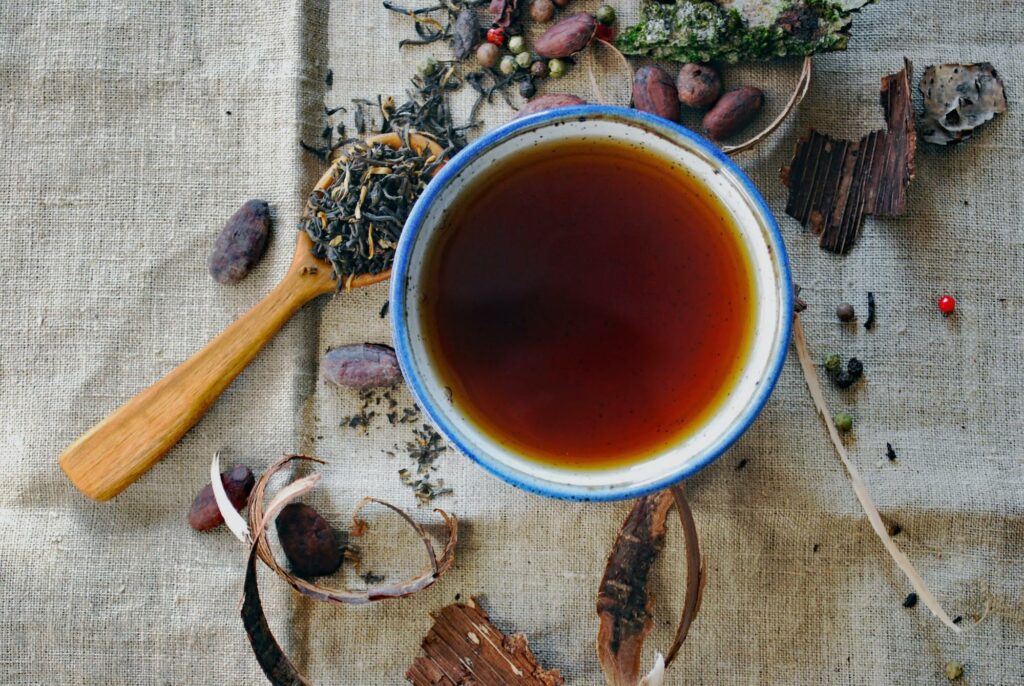
low-vibration foods to avoid
Now that you have a list of high-vibration foods to choose from, you might be wondering which foods to avoid on your next grocery shopping trip.
As a general rule of thumb, stay away from genetically modified (GMO) food, especially GMOs that have been treated with chemicals or pesticides. Genetically modified foods are not considered organic because they don’t grow naturally in the earth’s soil like most high-vibration foods.
Foods with added flavors, colors, sugar, and artificial sweeteners should also be avoided. Processed food is considered a low-vibration food because it usually has high amounts of sugar, sodium, and fats, which can lead to serious health conditions like obesity, heart disease, and high blood pressure.
Drinking soda, sports drinks, or water from a plastic bottle is said to cause lower vibrations. While some wines are considered organic if they’re sulfite-free and from organic farms, most alcoholic beverages would fall under this category.
Other low-vibration foods to avoid include:
- Instant coffee that’s not organic
- High fructose corn syrup
- Greasy fast foods
- Most microwaved foods or frozen foods
- Food and supplements with citric acid
- White, unbleached, or enriched flour
- Processed or canned foods
- Canola, palm, or vegetable oils
- Most meats, including beef, chicken, lamb, and pork
- Pasteurized milk, yogurt, or cheeses
- Deep-fried foods
If you find yourself eating many things on the low-vibration list, don’t feel discouraged. Our culture promotes these foods and many of them are consumed in the name of convenience.
You don’t need to change your diet overnight. That wouldn’t be a sustainable way to approach your lifestyle. Instead, notice the difference between these two kinds of foods and track your habits.
You can do this by keeping a simple food journal to track the foods you eat; leave space to document how you physically feel after eating each food. Depending on how your body reacts to what you’re eating, you’ll begin to understand what habits are healthy and which ones need to be changed.
We recommend food journaling for at least one or two weeks to get a full picture of your current diet. Remember not to judge yourself at this time. No one is going to see your food journal but you, so it’s a good place to start if you’re not sure which foods to cut and which foods can stay.
How to use this knowledge to create a diet quiz
As you learn more about your nutrition and continue attracting an audience that cares about the same things you do, consider creating an interactive quiz.
With a quiz, you will generate quality leads for your business, educate your audience on high-vibration foods, and inspire them to think differently about their nutritional habits.
Here are the steps to creating a quiz, complete with in-depth resources:
- Decide on a quiz topic and title
- Write your quiz result descriptions
- Choose the right questions and answers
- Customize your quiz design inside Interact
- Write a follow-up email sequence
- Publish your quiz on your website and social media
10 questions to use in your high-vibration foods quiz
As you create your diet quiz, you’ll need to choose quiz questions to make your quiz stand out. We recommend choosing seven to ten questions so you add enough value without overwhelming your audience.
Since there are so many layers to nutrition, health, and high-vibration diets, there are a variety of topics you can cover in your quiz. Feel free to use any of the questions on our list or get creative with your own!
Keep scrolling to see all of our quiz questions, or jump to your favorite:
- What food do you lean toward?
- How would you describe your diet?
- What kind of breakfast eater are you?
- Reading a nutritional label makes you want to…
- Which beverage would you choose?
- Would you describe your energy level as high, medium, or low?
- What is the best fruit?
- Would you like herbs for cooking or health?
- As a family, we eat veggies and salad…
- It’s 9:00 p.m. and you’re feeling a little hungry. Do you…
What food do you lean toward?
Most of us know what we should eat, but what we gravitate toward says a lot about our dietary habits. Asking about the foods quiz-takers lean toward is a no-brainer in a diet quiz.
Inside one of our quiz templates, you’ll find a list of options that correlates to various quiz result options. Naturally, the high-vibration options are fresh fruit and lots of veggies. Seafood can be healthy too, but it’s also believed that a person’s vibration lowers when they choose meats, carbs, and dairy instead of high-vibration foods.
This question will provide you with data on what your audience is most likely to eat. They may have different nutritional goals, but this question gets to the heart of their current diet. Based on their choices, you could follow up with recommended resources in an email sequence that’s sent after the quiz is completed.
You can use templated answers like:
- Lots of veggies
- Meat
- Fresh fruit
- Seafood
- Carbs
- Dairy
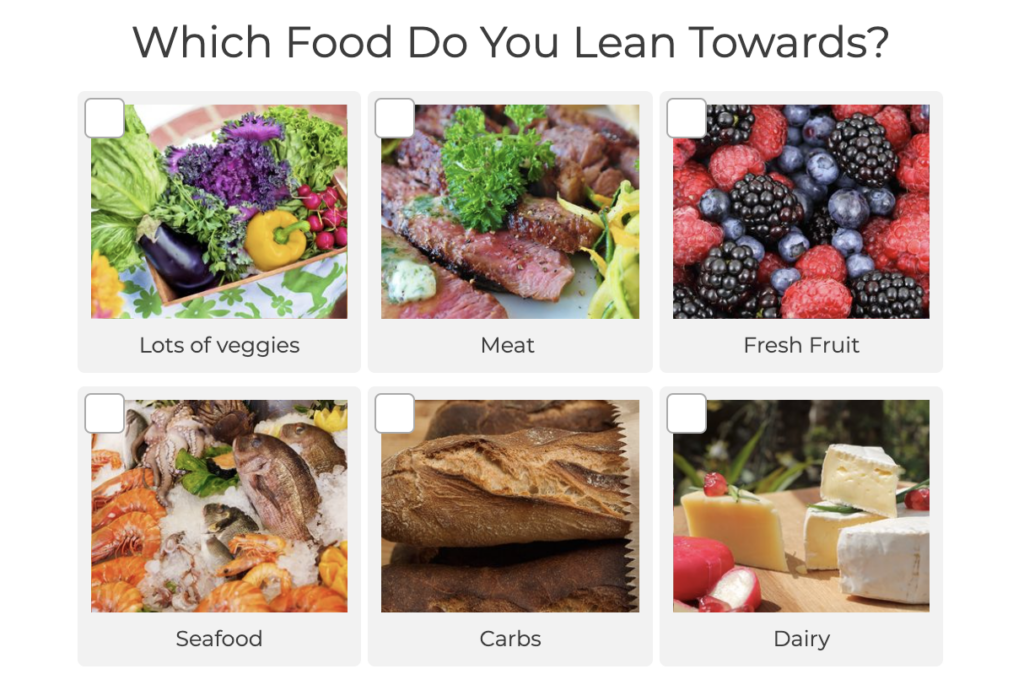
How would you describe your diet?
Quizzes can be a great place to have real conversations with your audience about their diet. It can sometimes be a tricky thing to talk about since most people consider nutrition a personal topic, but a quiz will give them a safe and encouraging place to explore their dietary habits.
To assess how much someone knows about their diet and what choices they are making, you can use this question with one of Interact’s quiz templates. When the quiz-taker answers this question honestly, it will give you a better idea of what foods they crave.
Based on this information, you could promote a high-vibration diet plan or even give them a grocery shopping list inside their quiz results. The sky’s the limit with what kind of valuable education you can provide after assessing the answers to this question.
You can use templated answers like:
- Low carb with larger portions of protein and fat
- Balanced with a mix of carbs, protein, and fat
- Low fat with little high-fat animal products or fried foods
- High carb with smaller portions of protein and fat
- High carb with high fat and smaller portion of proteins
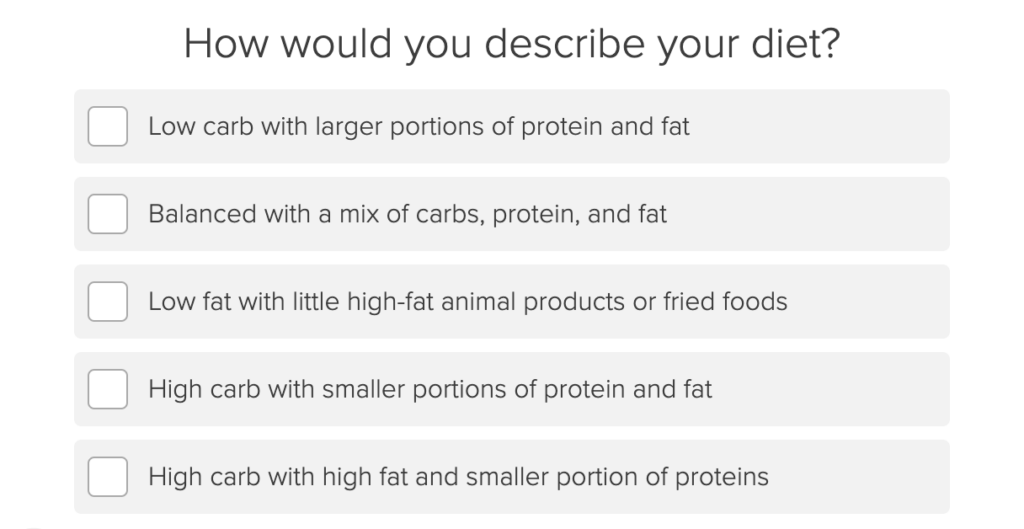
What kind of breakfast eater are you?
They say breakfast is the most important meal of the day, so this makes for an excellent question for your diet quiz. Instead of testing someone on their knowledge of healthy eating, you can assess their current habits on how they answer this question from the “What Do Your Food Choices Say About You?” quiz template.
If you’re not sure which foods to include, we have a few examples you can use! Remember, this is the perfect time to introduce a few high-vibration foods to your list of options to see if your audience is already eating them. If not, you can follow up with more tips on how to incorporate these foods into a healthy diet.
You can use templated answers like:
- Muffin, pancakes, sugary cereal, pastry, bagel
- Fruit, plain nonfat yogurt, avocado toast, veggie omelette, oatmeal
- Heavy on the bacon or sausage, cheese and potatoes, please.
- No breakfast. Nada.
(PS: You probably already noticed, but the second option here would be the best for those who want to incorporate a high-vibration diet into their lifestyle.)
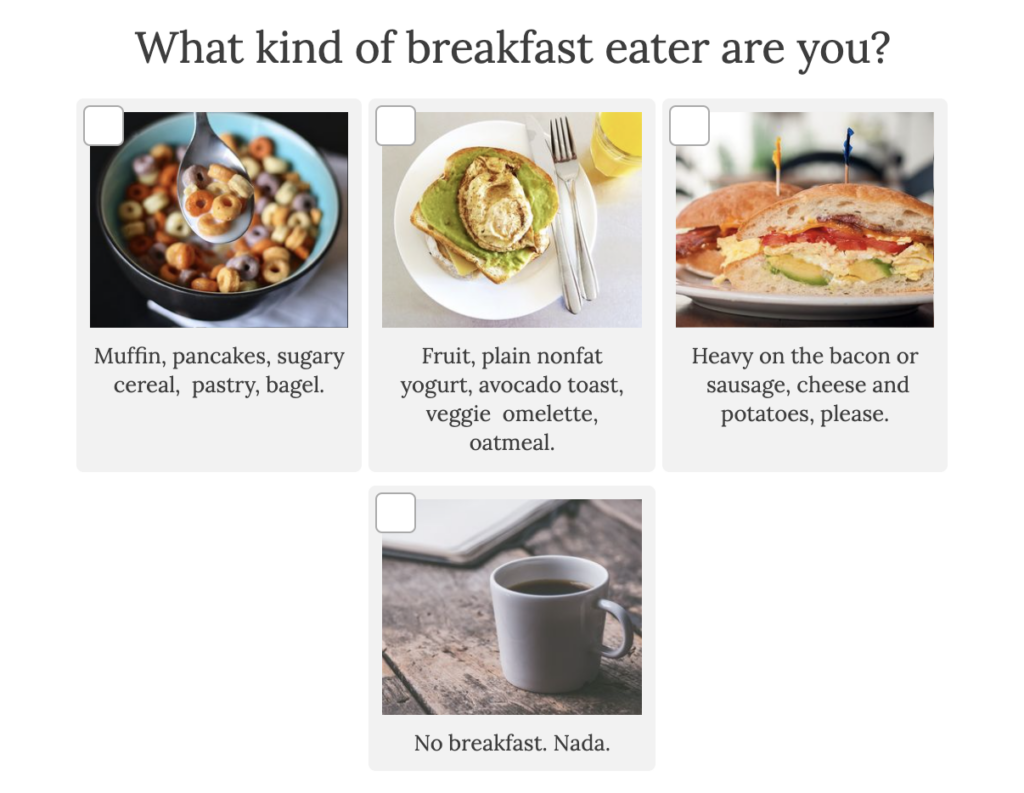
Reading a nutritional label makes you want to…
Is your audience more likely to read every ingredient inside a nutritional label or never look at them? Their answer will influence their food choices.
Someone who doesn’t look at nutritional labels may not be approaching their health from a place of intention, meaning they might be able to get more energy from choosing to eat healthier foods. Our “What Type of Eater Are You?” quiz template breaks down the different reactions a person may have when reading nutrition facts.
You can use templated answers like:
- Learn more about how to be healthy so I can understand labels better
- Eat everything!
- Be healthier
- Stop worrying so much about what I eat
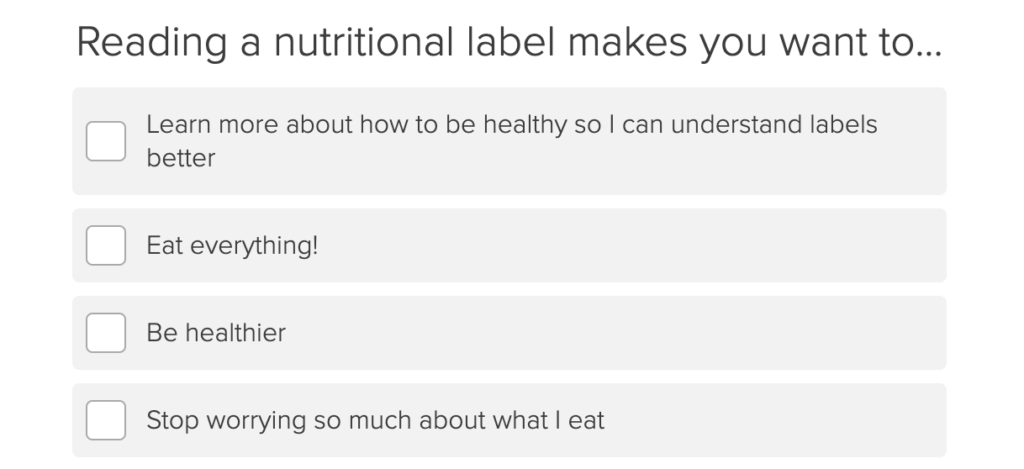
Which beverage would you choose?
Did you know beverages can have a low or high vibration, just like foods? We talked about the benefits of drinking kombucha or herbal teas to boost energy. There are also beverages that will zap your energy. Some of these include sodas with high fructose corn syrup, alcoholic drinks, sugary coffees, and more.
If you want to quiz your audience on their go-to beverage, use this sample question from our “What International Cuisine Should You Try?” quiz template. It will tell you a lot about a person’s current diet.
For example, if a quiz-taker chooses soda, it would reveal they have a low vibration. However, choosing water or juice (without added sugars) would lead to higher vibrations. You can swap out the beverages listed here depending on what your quiz goals are.
You can use templated answers like:
- Soda
- Iced tea
- Coffee
- Juice
- Water
- Milk
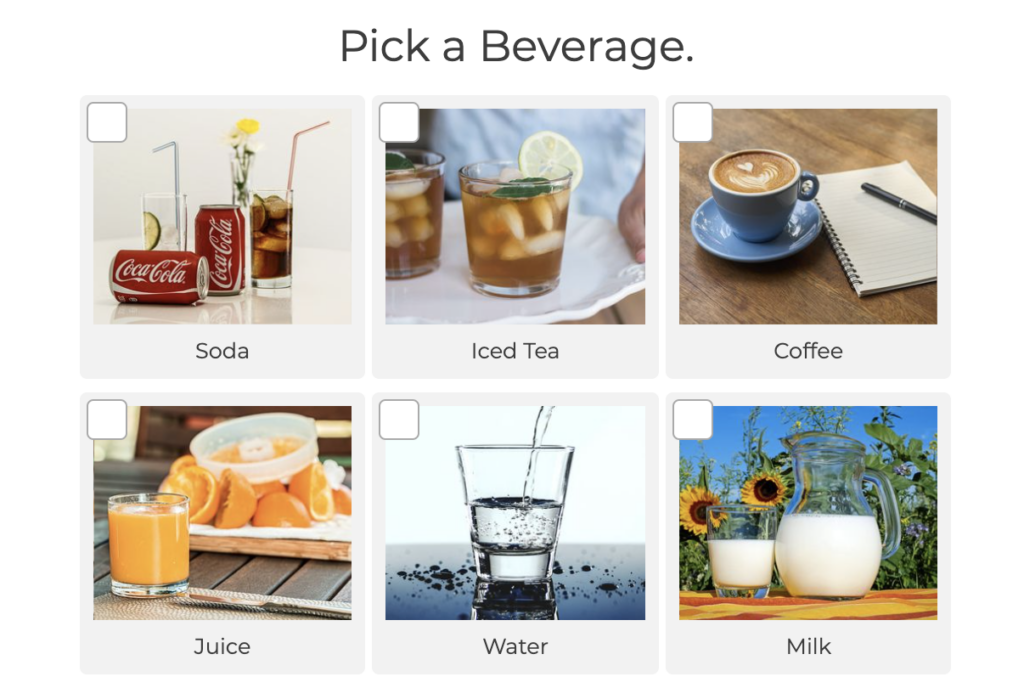
Would you describe your energy level as high, medium, or low?
When someone’s energy is low, it might be due to their nutritional habits. If you are creating a quiz to assess how much energy your quiz-taker currently has, this question from our “How Much Do You Know About Your Diet?” quiz template may help.
While the quiz template features a 19-question assessment in the form of a scoring quiz, you can also use this in a diet-focused personality quiz. Understanding someone’s energy levels will help you understand their eating habits, but it could also tell you more about their sleeping patterns, exercise habits, and more.

What is the best fruit?
By now, we know that organic fruits are one of the most highly vibrational foods. There is no “wrong” answer to this type of quiz question, which means it is perfect for those who want to create a personality quiz.
It may seem like an interesting choice, but this question can actually be found in our “What Vegetable Are You?” quiz template. Each answer option relates to a specific vegetable that has similar characteristics and fits the established personality types. This creates what we call the logic of your quiz.
Although this question is mostly for fun, one of its benefits is that it can be answered quickly since most people will immediately know their own preferences. A quiz that is faster to take usually leads to higher view-to-lead conversion rates. Keep this in mind when you create your quiz.
You can use templated answers like:
- Avocados
- Strawberries
- Pineapples
- Apples
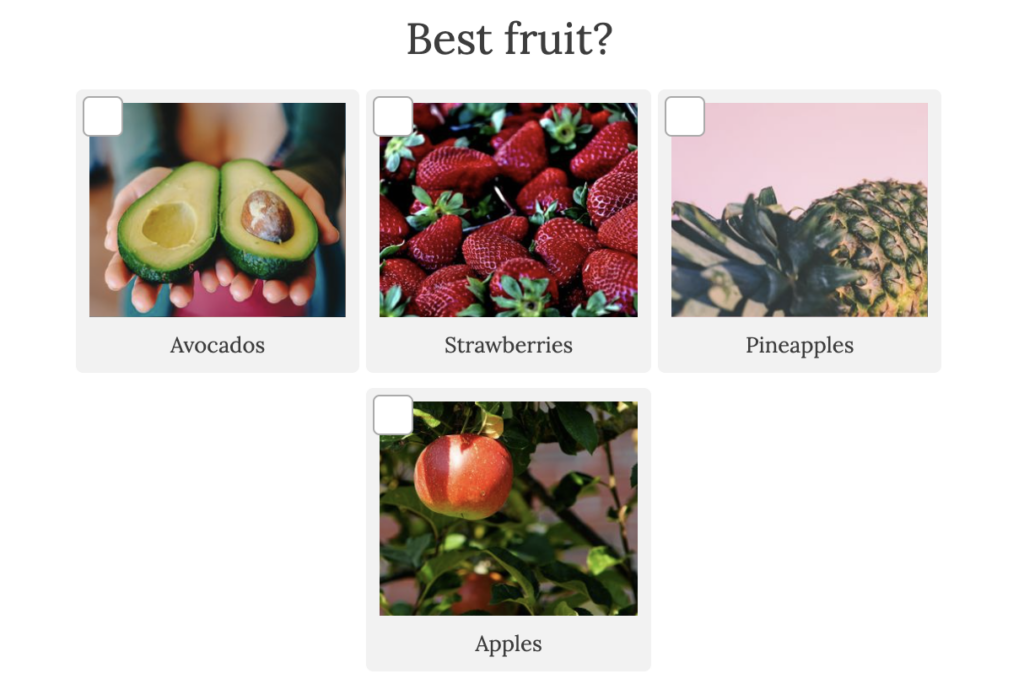
Would you like herbs for cooking or health?
Remember when we talked about the health properties of freshly grown herbs? That’s a big reason why this quiz question from our “Which Herb is Best For You?” quiz template made the list. Herbs are an easy and inexpensive way to add more energy to your daily diet.
If you want to encourage your audience to grow herbs at home or pick them up from their local farmers market, this question might be worth adding to your diet quiz. If someone takes your quiz and chooses any other option besides “I don’t really like herbs for any reason,” you can follow up with more tips and strategies for growing or selecting the right herbs.
You can use templated answers like:
- I cook every day with herbs
- Once in a while I grab some herbs
- I love using herbs for my health
- I don’t really like herbs for any reason
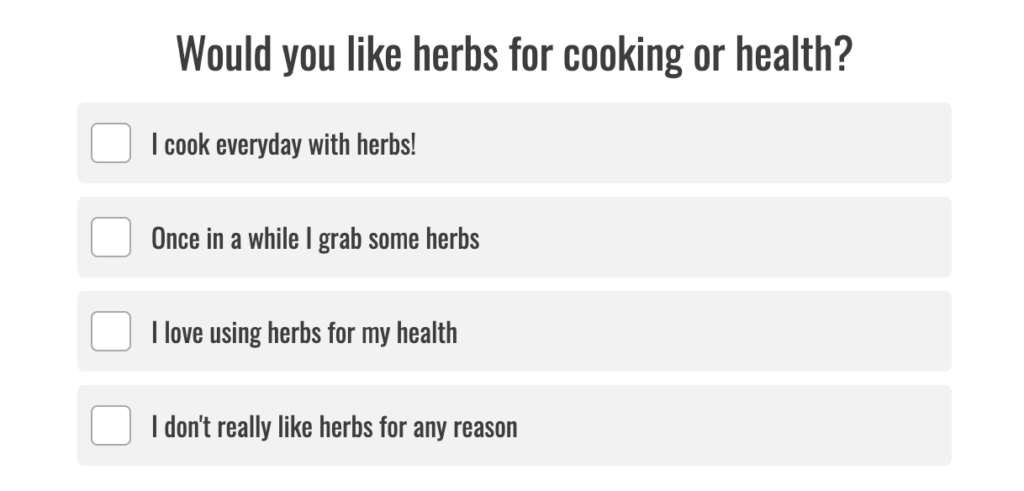
As a family, we eat veggies and salad…
Another great way to learn about someone’s nutrition is to understand how their eating habits affect their family. Some families love meal planning every week while others grab fast food for convenience. No matter who makes up your audience, the answer to this question will tell you a lot about how much energy they are consuming.
This quiz question is a good fit for business coaches who work with busy moms, food bloggers who focus on family nutrition, or health coaches. Feel free to use this question from our “How Well & Healthy Are You Feeding Your Family?” quiz template or any others from this example.
You can use templated answers like:
- Rarely, as the kids don’t like them
- A couple of times a week
- Every day, if not most meals
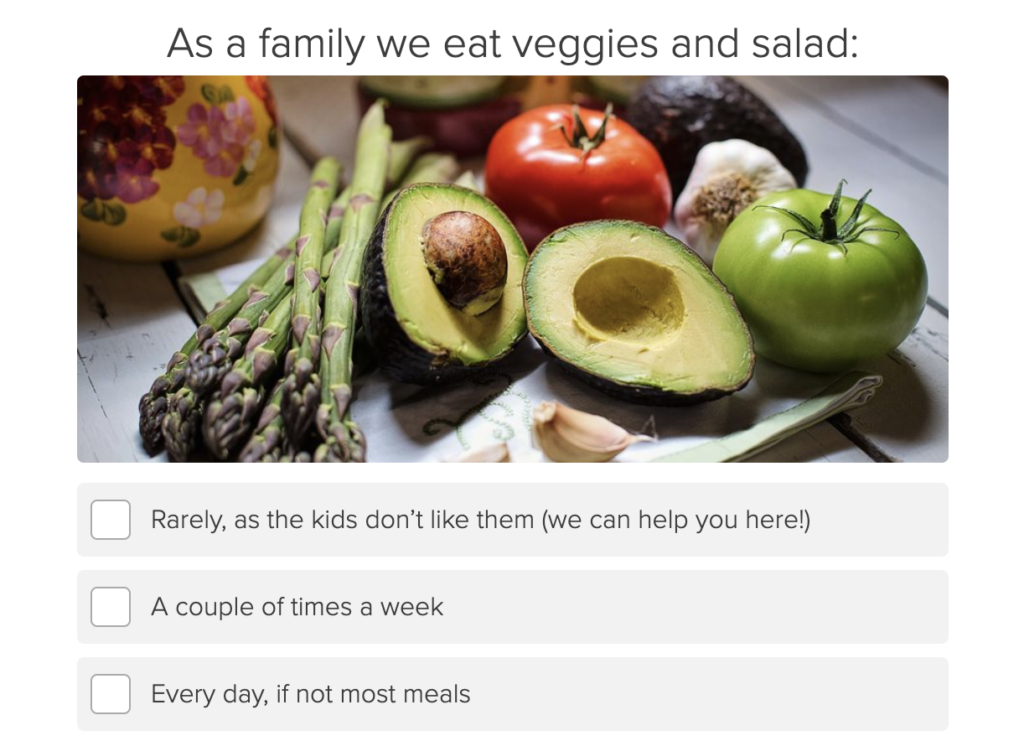
It’s 9:00 p.m. and you’re feeling a little hungry. Do you…
Who considers themselves a late-night snacker? What you reach for late at night says a lot about your nutrition. It’s easy to grab sugary snacks and junk food when it’s late, so this question can be insightful if quiz-takers are answering it honestly.
This question comes from our “What Do Your Food Choices Say About You?” quiz template, and it helps the quiz-creator understand their audience’s snacking preferences and what that says about their personality. It might also say a lot about the way they like to unwind after a long day.
You can use templated answers like:
- Start looking through the cupboards for something tasty
- Have a relaxing bath or cup of herbal tea instead
- Follow your late snacking rule: a little fruit, vegetable, or other healthy single-ingredient snack.
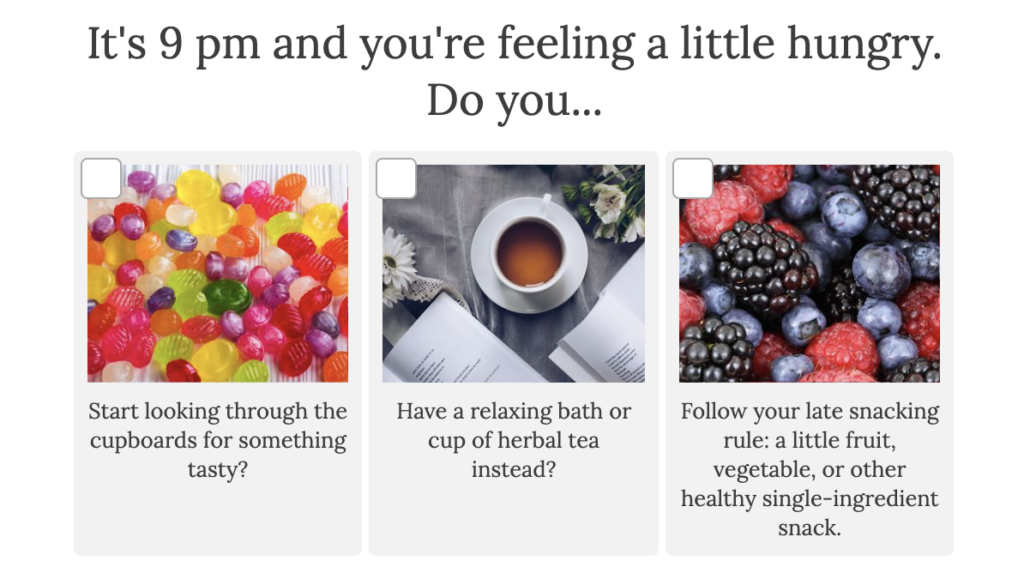
Create a diet quiz that incorporates high-vibration foods
Now you have everything you need to create your quiz! You can make high-vibration foods the main topic of your quiz or simply mention them in your answer options. No matter how you decide to incorporate these healthy themes, we’re excited to see what you will create.
The first step is to sign up for a free Interact account.
Do you still need convincing? Or are you not sure a quiz is the right move for you?
Read the below stories to find out how other experts have created successful quizzes:
- How Bethany From Primally Pure Generated $100,000+ from an eCommerce Quiz
- How “Quiz Funnel Queen” Chanti Zak Generated $50,000 from a Quiz
- How Elizabeth McCravy Generated $65k Revenue from a Personality Quiz
- How Kaye Putnam Generated $100k Revenue From Her Quiz
- Ashley Beaudin’s Guide to Generating 3k+ Leads in 1 Week with a Quiz